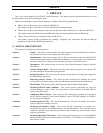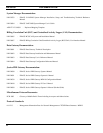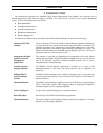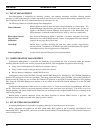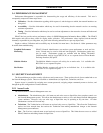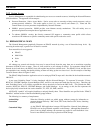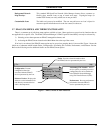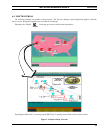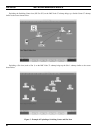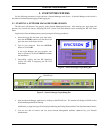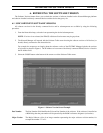
LBI-39169 INTRODUCTION
16
3.5.2 System Access
Security Management is responsible for administering user access to network resources, including the Network Elements
(NEs) themselves. The approach will encompass:
•
Password Protection: Native Access Mode -- Native access refers to currently existing security measures, such as
account-password validation. This mode applies to local (i.e., user console) and remote (i.e., Telnet and File
Transfer Protocol) access procedures implemented by Network Elements.
•
SNMPv1 protocol protection: SNMP provides some inherent security mechanisms. This will mainly serve as
protection against data corruption due to application errors.
•
To enhance SNMPv1 security, the directly connected NE supports a community name profile which allows
restriction of IP Addresses to specific community names with specific read-write access.
3.6 HIERARCHICAL MAPS
The Network Management graphically illustrates an EDACS network by using a set of hierarchical map levels. By
traversing down the maps, a greater level of detail is revealed.
Four network levels are suggested:
•
EDACS
•
Multi-Node
•
Node
•
Site
All submaps are created such that the icons may be moved freely about the map, there are no restrictions regarding
placement of EDACS icons on maps. Thus, all icons could be on one submap if desired. For customers without all the
network levels listed above, the EDACS icon will explode into the first available level. The EDACS, Node, and Site icons
are explodable icons, meaning that double-clicking on them will bring up the next lower level. See the examples of the Map
Traversal Screens shown in Figures 2 and 3.
The EDACS Map Generation Application assists in setting up EDACS maps and is described in the Installation manual,
LBI-39171.
A new term “Switching Center” is being introduced with the Network Manager. To represent 30 consoles, 32 sites,
BCU/CAL, CEC/IMC Manager, System Manager, EDG, and PI on one map would make the map very busy. Therefore, the
term “Switching Center” was coined to represent the devices physically located at the IMC Node. This includes the IMC,
consoles, BCU/CAL, EDG, PI, CEC/IMC Manager, and System Manager. As an analogy to this, the Site represents the
devices physically located at the site such as channels, TU, ACU, SC, PMU, and ELI.
All EDACS “symbols” will require identifiers to uniquely identify them. These identifiers are specified in the “EDACS
Identifiers” attribute section of the Describe/Modify popup window.
The following is a summary of map features:
Assisted Map
Generation
When the following symbols are added, popup windows prompt for information to
generate the map hierarchy: IMC Node, CEC Node, Remote CEC Node, Switching
Center, and Site.
Customized Maps
As the EDACS NM application leverages HP OpenView Network Node Manager,
EDACS icons can be positioned anywhere on the submap. Although Map Generation
places icons on default submaps, the customer may create his own hierarchical view.
Icons for non-EDACS devices may be placed on EDACS maps.




